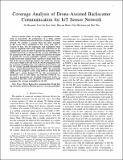| dc.contributor.author | Hayajneh, Ali | |
| dc.contributor.author | Zaidi, Syed Ali Raza | |
| dc.contributor.author | Hafeez, Maryam | |
| dc.contributor.author | McLernon, Des | |
| dc.contributor.author | Win, Moe Z. | |
| dc.date.accessioned | 2020-01-23T13:27:56Z | |
| dc.date.available | 2020-01-23T13:27:56Z | |
| dc.date.issued | 2019-08 | |
| dc.identifier.isbn | 9781728105703 | |
| dc.identifier.uri | https://hdl.handle.net/1721.1/123551 | |
| dc.description.abstract | In this article, we develop a comprehensive framework to characterize the performance of drone assisted Backscatter communication based Internet of things (IoT) sensor network. We consider a scenario such where drone transmits RF carrier which is modulated by IoT sensor node (SN) to transmit its data. The SN implements load modulation which results in amplitude shift keying (ASK) type modulation for the impinging RF carrier. In order to quantify the performance of the considered network, we characterize the coverage probability for the ground based SN node. The statistical framework developed to quantify the coverage probability explicitly accommodates dyadic backscatter channel which experiences deeper fades than that of the one-way Rayleigh channel. Our model also incorporates Line of Sight (LoS) and Non-LoS (NLoS) propagation states for accurately modeling large-scale path-loss between drone and SN. We consider spatially distributed SNs which can be modelled using spatial Binomial Point process (BPP). We practically implement the proposed system using Software Defined Radio (SDR) and a custom designed SN tag. The measurements of parameters such as noise figure, tag reflection coefficient etc., are used to parametrize the developed framework. Lastly, we demonstrate that there exists an optimal set of parameters which maximizes the coverage probability for the SN. | en_US |
| dc.language.iso | en | |
| dc.publisher | IEEE | en_US |
| dc.relation.isversionof | http://dx.doi.org/10.1109/dcoss.2019.00108 | en_US |
| dc.rights | Creative Commons Attribution-Noncommercial-Share Alike | en_US |
| dc.rights.uri | http://creativecommons.org/licenses/by-nc-sa/4.0/ | en_US |
| dc.source | Other repository | en_US |
| dc.title | Coverage Analysis of Drone-Assisted Backscatter Communication for IoT Sensor Network | en_US |
| dc.type | Article | en_US |
| dc.identifier.citation | Hayajneh, Ali et al. "Coverage Analysis of Drone-Assisted Backscatter Communication for IoT Sensor Network." 2019 15th International Conference on Distributed Computing in Sensor Systems (DCOSS), 29-31 May 2019, Santorini Island, Greece, IEEE, 2019 | en_US |
| dc.contributor.department | Massachusetts Institute of Technology. Laboratory for Information and Decision Systems | en_US |
| dc.relation.journal | 2019 15th International Conference on Distributed Computing in Sensor Systems (DCOSS) | en_US |
| dc.eprint.version | Author's final manuscript | en_US |
| dc.type.uri | http://purl.org/eprint/type/ConferencePaper | en_US |
| eprint.status | http://purl.org/eprint/status/NonPeerReviewed | en_US |
| dc.date.updated | 2019-11-04T16:03:04Z | |
| dspace.date.submission | 2019-11-04T16:03:07Z | |
| mit.metadata.status | Complete | |
